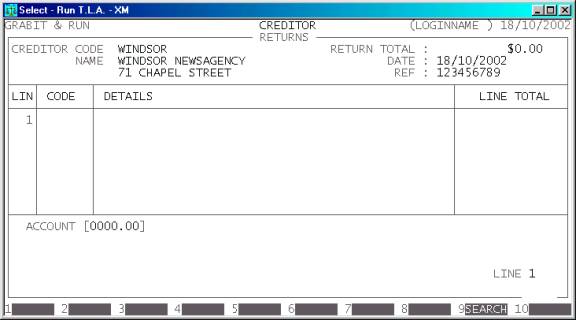Total
Legal Accounting 3
SECTION
5.3.2 - CREDIT-NOTES
USAGE: To undo a Purchase previously entered. This
function does not actually delete the Purchase but allows you to enter a
reversing transaction that will return stock, and reduce the Creditor’s
balance, etc.
DISCUSSION: When you start the CREDIT-NOTE program,
the computer will initially ask for a Creditor code. Insert the code and press <Enter>.
To return to the CREDITOR DATA ENTRY MENU, press <ESC>.
To search for a Creditor, press <F9>. For further details on searches, see SECTION 1.2.
Having chosen a Creditor, the screen will display
the name and address and recent balances, in full at the top of the screen.
You will then be asked a series of questions. These
relate to the ribbon information on the RETURN.
The exact list of fields displayed depends on how you have chosen the options
in SYSTEM DEFAULTS. (See SECTION 7.1.2.) Fields that are not displayed take
their values from the defaults set on the Creditor’s master-file.
The following is a complete list of possible fields:
Name Comments
DATE This defaults to the system date (the date at the top
of the screen). If you change it, T.L.A. will retain the changed date until you
exit to the CREDITOR DATA ENTRY MENU.
If you have changed the date and wish to return to the system date, press <F1>.
THEIR INVOICE # This is a compulsory field. Here you enter the invoice
number from your supplier. It is an alphanumeric field. If there is no invoice
number, you can enter the date or some other reference.
OUR ORDER # This is a non-compulsory field. If you have purchased the goods via
an order, you can enter the order number here as a reference. This helps to
keep all the information in one place.
CREDITOR’S NAME If you are purchasing from the Creditor SUNDRY, T.L.A. will ask you to enter the actual name of
the Creditor. The Sundry Creditor is treated differently from other Creditors
in that it can be singled out for exclusion in certain reports. The modified
name will be displayed in CREDITOR
ENQUIRIES but will not be saved to the Creditor master-file record.
At each point, you may cancel the RETURN
by pressing <ESC>. However, it is possible to
return to a specific field by using <CsrUp> or <F8>.
After answering these fields the screen will repaint
and display as follows. Note that at this point there is no way to go back to
the above questions, except by cancelling the RETURN and starting
again.

Here you may enter the complete details of each RETURN line.
CODE This is the general Ledger Code. You may enter a
code here or press <F9> to initiate a search.
DETAILS Here you must enter the description of the purchase.
VALUE Enter the value of the line.
At each point you may press <ESC> to abort the line or the whole transaction.
If you have entered at least one line, you may press
<F5> (at the CODE field) to enter the REVIEW function.
This function allows you to view your entries, and if necessary change or
delete a line. To move between lines use <CsrUp>, <CsrDn>, <PageUp>, <PageDn>, <Home> and <End>. If there is a particularly large number of lines,
you can also use <F9> to go to a specific line
number. To modify a line, make sure it is displayed in full in the bottom
window and press <F3>. You can then re-enter any
of the details. To leave the REVIEW function, press <ESC> or <F10>, once.
At the end of the RETURN, you will be presented with a summary and you will be asked
to confirm the update. This is the point of no return. Once you answer Y, T.L.A. will update all the relevant files. Up to this point you can
cancel or modify the details.
After the RETURN you will be returned to the
Creditor code entry screen where you may either enter another RETURN or press <ESC> to return to the CREDITOR DATA ENTRY MENU.
Files updated by the Return program:
Creditor
master-file: The total of the return is
posted to the Creditor’s record.
Creditor
Group file: The totals posted to the
Creditor are mimicked in the Creditor Group file. This allows you to quickly
view the sales for a group without having to generate a report.
Creditor
transaction file: Each Return
generates a transaction. This can be viewed in CREDITOR ENQUIRIES and is used to create reports, such as REMITTANCE ADVICES.
Return
image file: Every Return creates a
print image on disk. This is then used to print the details of the Return. You
can either print the image at the time you create the Purchase or you can use
the CREDITOR ENQUIRIES program to
print (or re-print) the details.
General
Ledger master-file: This is updated in two
ways. A) if you post a line directly to General Ledger, the value will be
posted to the relevant account. B) in addition to this several accounts are
automatically posted to, eg Stock on hand and Trade Creditors. These accounts
must be defined in the GENERAL LEDGER
CONTROL ACCOUNTS.
General
Ledger transaction-file: A
transaction is posted for each General Ledger transaction line and for the
totals described above.